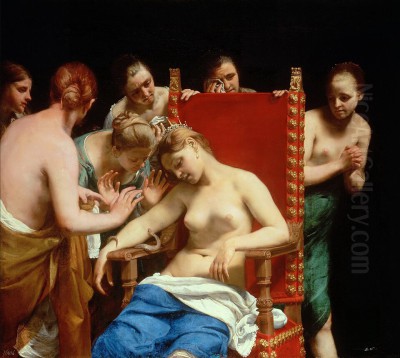
Guido Cagnacci stands as one of the most intriguing, eccentric, and ultimately rediscovered figures of the Italian Baroque period. An artist of profound originality and sensuous power, his life was as unconventional as his art, marked by wanderings, scandal, and a unique artistic vision that often placed him at odds with contemporary tastes yet secured him a distinctive place in art history. His paintings, characterized by their startling naturalism, dramatic chiaroscuro, and an often unsettling eroticism, continue to captivate and provoke audiences today.
Early Life and Artistic Genesis in Romagna and Bologna
Guido Cagnacci was born in Santarcangelo di Romagna, a small town near Rimini, with his baptism recorded on January 19, 1601, though some sources suggest January 13 as his birthdate. His father, Matteo Cagnacci, was a tanner and fur merchant, while his mother, Sevilia Rasi, hailed from a noble family in Sarsina. This mixed heritage, combining mercantile pragmatism with aristocratic lineage, perhaps prefigured the artist's own complex and often contradictory nature.
Little is definitively known about Cagnacci's earliest artistic training, though it is believed he was largely self-taught in his formative years. His innate talent must have been apparent, as he was sent to Bologna around 1617-1618 to further his studies. Bologna at this time was a vibrant artistic center, dominated by the legacy of the Carracci family – Ludovico, Annibale, and Agostino Carracci – who had revolutionized Italian painting by advocating a return to naturalism and classical principles, moving away from the artificiality of late Mannerism.
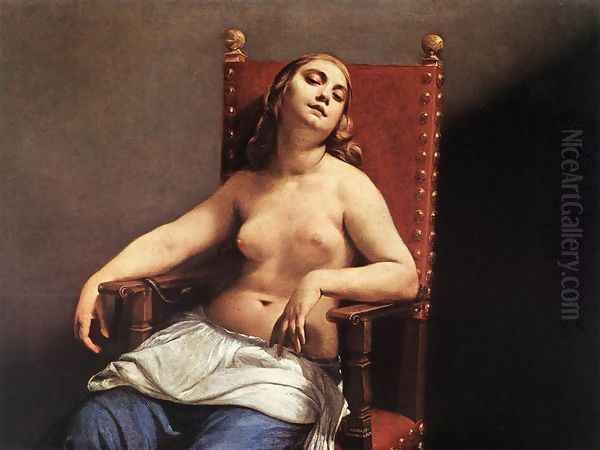
In Bologna, Cagnacci is thought to have briefly studied with Ludovico Carracci, or at least to have been deeply immersed in the artistic environment shaped by the Accademia degli Incamminati. However, the most significant influence from this period was undoubtedly Guido Reni, one of the Carracci's most celebrated pupils and a leading master of the Bolognese school. Reni's elegant classicism, refined figures, and delicate palette left an imprint on Cagnacci, though the younger artist would soon diverge towards a more robust and earthy naturalism. Another key figure in Bologna was Guercino (Giovanni Francesco Barbieri), whose dynamic compositions and dramatic use of light and shadow also resonated with Cagnacci. The two reportedly became acquainted, and Guercino's early, more tenebrist style likely offered a compelling alternative to Reni's idealism.
Roman Sojourn and the Impact of Caravaggio
Between approximately 1619 and 1621, Cagnacci undertook the customary journey to Rome, the epicenter of the art world. Here, he would have encountered a dazzling array of artistic currents. The towering influence was Michelangelo Merisi da Caravaggio, who, though deceased for a decade, had irrevocably changed the course of painting with his revolutionary naturalism, dramatic use of chiaroscuro (tenebrism), and depiction of religious scenes with an unprecedented immediacy and psychological intensity, often using common people as models.
Caravaggio's impact on Cagnacci was profound and lasting. The Lombard master's unidealized figures, his theatrical lighting, and his ability to convey raw human emotion resonated deeply with Cagnacci's own artistic temperament. While in Rome, Cagnacci would also have seen works by Caravaggio's followers, known as the Caravaggisti, such as Bartolomeo Manfredi, Orazio Gentileschi, and his daughter Artemisia Gentileschi, as well as foreign artists like Simon Vouet and Jusepe de Ribera who had absorbed the Caravaggesque style. He may also have encountered artists like Giovanni Lanfranco or Giovanni Baglione. The experience in Rome solidified Cagnacci's inclination towards a powerful, often stark, realism.
Return to Romagna and Early Commissions
Upon returning to Romagna around 1621, Cagnacci began to receive commissions, primarily for religious works in local churches. He worked in various towns, including Rimini, Forlì, and his native Santarcangelo. His style during this period shows a synthesis of his Bolognese training and Roman experiences. Works like the Calling of Saint Matthew (circa 1625-1630) demonstrate his engagement with Caravaggesque principles, particularly in the dramatic lighting and the realistic portrayal of figures.
However, Cagnacci's life in Romagna was not without turmoil. A significant and scandalous event occurred in 1628: his attempted elopement with Teodora Stivivi, a wealthy and well-connected widow of noble standing. The plan was discovered, leading to Cagnacci's disgrace and forcing him to flee. This episode highlights Cagnacci's rebellious streak and disregard for societal conventions, traits that would also manifest in his art. The scandal likely made it difficult for him to secure further patronage in the region, prompting his subsequent itinerant career.
Years of Wandering: Forlì, Venice, and the Development of a Mature Style
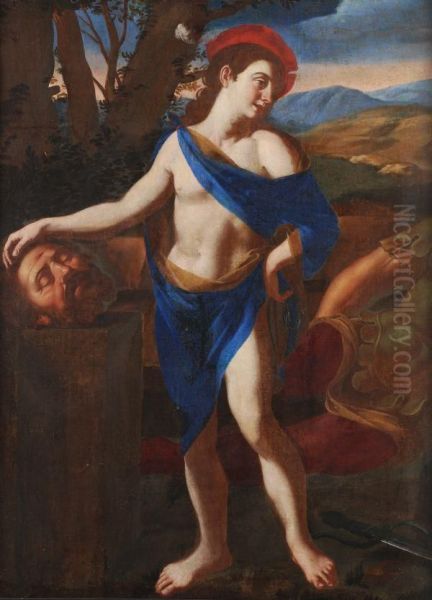
After the elopement scandal, Cagnacci's movements become somewhat harder to trace with precision, but he is known to have worked in Forlì, where he created significant altarpieces. His style continued to evolve, often oscillating between a more classical refinement reminiscent of Reni and a starker, more sensual naturalism.
By the late 1640s, Cagnacci had moved to Venice, a city with its own rich artistic traditions, distinct from those of Rome and Bologna. Venetian art, exemplified by masters like Titian, Tintoretto, and Veronese, was celebrated for its emphasis on color (colorito) and painterly brushwork. While in Venice, Cagnacci's art took a decisive turn. He began to focus increasingly on half-length figures and cabinet pictures, often depicting secular, mythological, or allegorical subjects with a pronounced sensuality.
His palette became richer and more luminous, and his handling of flesh tones achieved a remarkable softness and vibrancy. It was in Venice that he developed his signature depictions of languid, seductive female figures, often in various states of undress. Works from this period, such as his numerous versions of Lucretia, Cleopatra, and Mary Magdalene, showcase this new direction. He associated with other artists in Venice, including Pietro Liberi, whose own work shared a similar penchant for sensuous and decorative themes. He also likely absorbed influences from earlier Venetian masters like Palma Vecchio and Giorgione, known for their poetic and often enigmatic portrayals of the female form.
Masterpieces of Sensuality and Psychological Depth
Cagnacci's Venetian period, and his subsequent time in Vienna, produced some of his most iconic and controversial works. These paintings are characterized by their technical brilliance, their psychological insight, and their unabashed celebration of the female body.
The Repentant Magdalene: Cagnacci painted several versions of Mary Magdalene, a subject that allowed for the depiction of both piety and sensuality. His Magdalenes are often shown in moments of emotional turmoil, their repentance tinged with a lingering worldliness. The version now in the Norton Simon Museum, Pasadena, is a prime example. The Magdalene, half-nude, is depicted with tear-filled eyes, her luxurious hair cascading over her shoulders, her body rendered with a palpable softness. The interplay of light and shadow accentuates the textures of her skin, hair, and the rich fabrics surrounding her, creating an image that is both spiritually charged and intensely physical.
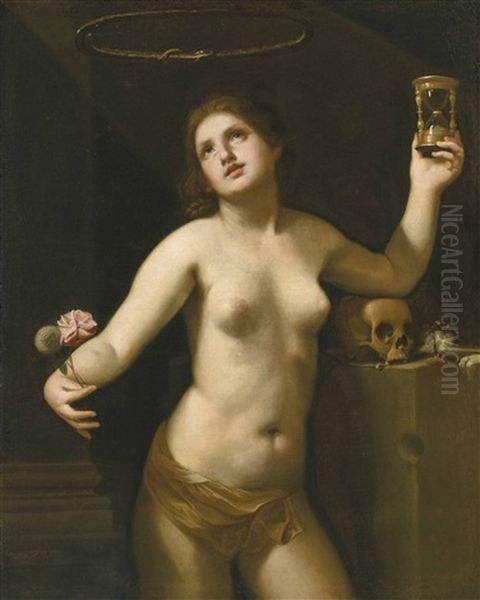
The Death of Cleopatra: Another recurring theme was the suicide of Cleopatra. Cagnacci's Cleopatras are typically shown in the moments before or after the asp's bite, her regal beauty juxtaposed with the imminence of death. These paintings, such as the version in the Kunsthistorisches Museum, Vienna, or the one in the Pinacoteca di Brera, Milan, are masterpieces of dramatic tension and sensuous appeal. Cleopatra's languid pose, her exposed breast, and the opulent setting create an atmosphere of tragic eroticism. The artist's skill in rendering flesh tones and luxurious textiles is particularly evident in these works.
David with the Head of Goliath: While renowned for his female figures, Cagnacci also tackled male subjects with vigor. His David with the Head of Goliath (e.g., J. Paul Getty Museum version) presents a youthful, almost androgynous David, his expression a mixture of triumph and introspection. The severed head of Goliath is rendered with gruesome realism, a stark contrast to David's smooth skin and delicate features. This work demonstrates Cagnacci's debt to Caravaggio, not only in the dramatic lighting but also in the psychological intensity of the scene.
Allegory of Human Life (or Allegory of Painting): Some of Cagnacci's most complex and enigmatic works are his allegories. The painting often identified as Allegory of Human Life or sometimes Allegory of Painting (various versions exist) typically features a beautiful nude woman, often holding a mirror or surrounded by symbols of vanity and the transience of life, such as flowers, jewels, and skulls. These works are rich in symbolic meaning and showcase Cagnacci's ability to combine intellectual depth with visual allure. The depiction of the female nude in these allegories is often startlingly direct and unidealized, pushing the boundaries of contemporary decorum.
His approach to the nude was distinctive. Unlike the idealized nudes of the High Renaissance or the more academic nudes of some of his Bolognese contemporaries like Domenichino or Francesco Albani, Cagnacci's nudes possess a tangible, almost palpable reality. They are not goddesses or abstract personifications but flesh-and-blood women, whose sensuality is an integral part of their being. This directness, combined with the often ambiguous narratives of his paintings, contributed to his reputation as a provocative and unconventional artist.
The Vienna Years: Court Painter to Emperor Leopold I
Around 1658, Cagnacci moved to Vienna, having been summoned by Emperor Leopold I to serve as a court painter. This appointment marked the culmination of his career, providing him with prestigious patronage and a degree of stability he had not previously enjoyed. In Vienna, he continued to produce works for the imperial court, including portraits and his characteristic mythological and allegorical scenes.
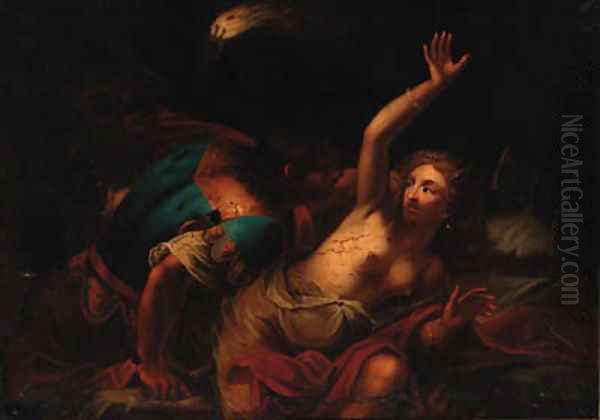
His style in Vienna retained its sensuousness and technical refinement, though some works from this period exhibit a slightly cooler palette and a more polished finish, perhaps in deference to courtly tastes. Despite his success at court, Cagnacci's later years seem to have been marked by a degree of isolation. He never married and had no known children. His unconventional lifestyle and perhaps his somewhat difficult personality may have contributed to this. He died in Vienna in 1663, at the age of approximately 62.
Artistic Style: A Synthesis of Opposites
Cagnacci's artistic style is a fascinating amalgamation of diverse influences, forged into a highly personal and recognizable idiom. Key characteristics include:
Naturalism and Realism: Heavily influenced by Caravaggio, Cagnacci often depicted figures with an unidealized, almost raw realism. This is particularly evident in his rendering of flesh, which has a tangible, lifelike quality.
Chiaroscuro: He was a master of dramatic lighting, using strong contrasts between light and shadow to model forms, create atmosphere, and heighten emotional intensity. While Caravaggesque in origin, his chiaroscuro could also be softer and more diffused, particularly in his later works.
Sensuality: Cagnacci's art is imbued with a powerful sensuality, most notably in his depictions of the female nude. His figures are often languid, seductive, and erotically charged, challenging the conventional boundaries of religious and mythological painting.
Psychological Insight: Beyond mere physical representation, Cagnacci imbued his figures with a sense of inner life and psychological complexity. His characters often convey a range of emotions, from ecstasy and despair to contemplation and cunning.
Rich Color and Texture: Especially in his Venetian and Viennese periods, Cagnacci demonstrated a sophisticated use of color and a remarkable ability to render diverse textures, from soft skin and flowing hair to sumptuous fabrics and gleaming metal.
Eclecticism: Cagnacci drew from various sources – the Bolognese classicism of Reni, the naturalism of Caravaggio, and the colorism of Venetian painting. He was not a slavish imitator but rather synthesized these elements into a unique and original style. Artists like Bernardo Strozzi or the German painter Johann Liss, also active in Venice, shared some of this eclectic spirit, blending northern and Italian traditions.
Controversies and Critical Reception
Throughout his career and posthumously, Cagnacci has been a figure of controversy. His overt eroticism and the perceived indecency of some of his works drew criticism from some quarters. In Venice, for instance, some critics reportedly dismissed him as capable only of painting half-length figures, implying a lack of skill in more complex, multi-figure compositions, a criticism that seems unfair given the ambition of some of his larger altarpieces.

His personal life, particularly the elopement scandal, also contributed to his somewhat notorious reputation. The use of models who, according to some accounts, might have been women dressed as men, or who were simply perceived as being of questionable morals, further fueled contemporary gossip and later art historical speculation.
For many years after his death, Cagnacci was a relatively neglected figure, particularly in Italy. His works were more appreciated in Northern Europe, especially in Germany and Austria, where many of his paintings found their way into collections. The lack of a significant workshop or direct followers also meant that his influence was not as widespread as that of some of his contemporaries.
Legacy and Rediscovery
The 20th and 21st centuries have witnessed a significant reassessment and rediscovery of Guido Cagnacci. Art historians and the public alike have come to appreciate his originality, his technical skill, and the unique power of his artistic vision. Exhibitions dedicated to his work have brought his paintings to a wider audience, highlighting his importance as a distinctive voice within the diverse landscape of Italian Baroque art.
He is now recognized as an artist who, while working within the broader currents of his time, forged a deeply personal style. His ability to infuse traditional subjects with a startling immediacy and a potent, often unsettling, sensuality sets him apart. He explored the complexities of human emotion and the allure of the physical body with an honesty and intensity that can still feel remarkably modern.
Cagnacci's art challenges easy categorization. He was not strictly a Caravaggisto, nor a straightforward follower of Reni or the Venetian school. Instead, he was a maverick, an artist who absorbed diverse influences but ultimately followed his own idiosyncratic path. His paintings, with their blend of sacred and profane, spiritual intensity and earthly desire, continue to fascinate and provoke, securing Guido Cagnacci's place as one of the most compelling and individualistic masters of the Baroque era. His legacy lies in his daring exploration of the human condition, rendered with a brush that was both exquisitely refined and brutally honest.